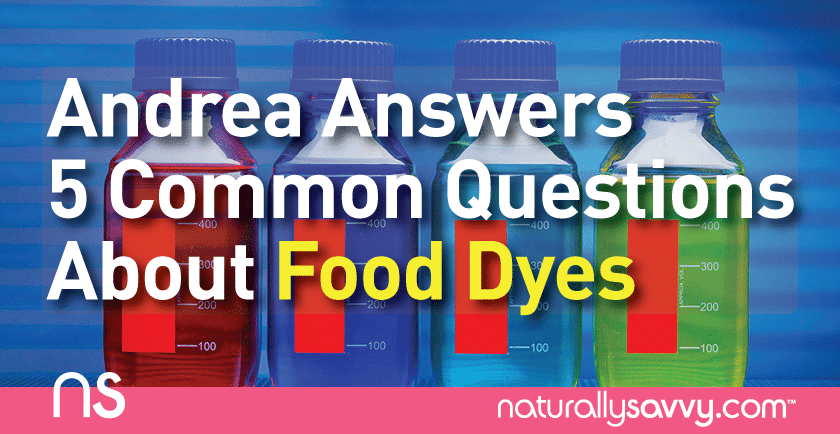

NaturallySavvy.com interviews Andrea Donsky, founder of Naturally Savvy to get her take, as a mom and health expert, on the dangers of food dyes and how to avoid them.
1. Where do food dyes show up most?
Andrea Donsky: As a mom to three kids, food dyes show up for me and my family mostly in foods and beverages. However, they also can be found in vitamins, pharmaceutical drugs, cosmetics, and personal care products. There are seven dyes approved by the FDA for general use in food. They are: FD&C Blue #1 (Brilliant Blue), FD&C Blue #2 (Indigotine), FD&C Green #3 (Fast Green), FD&C Red #3 (Erythrosine), FD&C Red #40 (Allura Red), FD&C Yellow #5 (Tartrazine), and FD&C Yellow 6 (Sunset Yellow).
Read more: 7 Scary Food Additives to Avoid
2. Why should parents and consumers be concerned about artificial food dyes?
Andrea Donsky: Artificial dyes contain various chemicals and are commonly derived from petroleum products. Our brains are hardwired to recognize colorful food as healthy and nutritious. Artificial dyes in food (and especially candy) wake up that subconscious part of the brain to say, “I’m ripe, and I’m food for you! Eat me!” – which couldn’t be further from the truth. Food colors actually influence our how our brains perceive taste, and one study found that people rated the same food as better tasting with color added. This shows us how conditioned we are to how food “should” look, so we ignore the artificial process that is used to make it look that way.
Read more: Artificial Colors and Health Concerns
3. What reported reactions are linked to artificial food coloring?
Andrea Donsky: Most artificial dyes have been linked to hyperactivity, attention deficit disorder (ADD), and attention deficit/hyperactivity disorder (ADHD). In 2004, an analysis of fifteen studies found evidence that artificial colors worsen the behavior of children with ADHD, and two more studies found that they negatively affect the behavior of children without behavioral disorders.
Read more: An (Accidental) Food Coloring Experiment
4. What are the worst artificial food dyes to avoid?
Andrea Donsky: In my opinion they should all be avoided. However, if I had to choose I would say Yellow 5, Yellow 6, and Red 40. Yellow 5, the second most widely used artificial color, may contain carcinogenic chemicals, and could cause hyperactivity or allergic reactions. Yellow 6 has been shown to cause tumors in animals, stomach cramps, and rashes. In one study Red 40 showed to speed up the growth of tumors in mice, whereas another didn’t. At the end of the day there just isn’t enough evidence to guarantee its safety.
Read more: 3 Not-So-Natural Food Dyes to Avoid
5. Do other countries have similar usage and regulation for artificial food dyes?
Andrea Donsky: Unfortunately the U.S. and Canada still allow artificial dyes to be used in foods that several countries in Europe have banned (i.e. Norway, U.K., and Austria). In Europe most companies that choose to use chemical dyes must prominently display a warning label that consuming their products could be linked to behavior issues in kids. In many cases companies reformulate their products to be sold in Europe. For example, in Britain, Kellogg’s Nutri-Grain bars are made with natural dyes like beetroot and paprika, but they contain artificial dyes in the U.S. and Canada. The good news is things are changing and companies are starting to remove artificial dyes from their products. Nestle recently announced it’s pulling artificial colors and flavors from its products sold in the U.S. Other companies like Mars, Kraft, Campbell's, General Mills and more have followed suit. This is a giant step in the right direction.
Read more: 5 Major Food Brands Ditching Artificial Colors and Flavors




